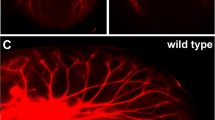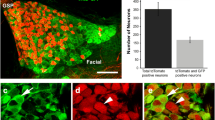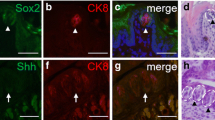Abstract.
Brain-derived neurotrophic factor (BDNF) and neurotrophin-3 (NT-3) mRNAs are expressed in the developing rat tongue and taste organs in specific spatiotemporal patterns. BDNF mRNA is present in the early lingual gustatory papilla epithelium, from which taste buds eventually arise, prior to the arrival of gustatory nerve fibers at the epithelium, whereas NT-3 initially distributes in the mesenchyme. However, a direct test for neural dependence of neurotrophin expression on the presence of innervation in tongue has not been made, nor is it known whether the patterns of neurotrophin expression can be replicated in an in vitro system. Therefore, we used a tongue organ culture model that supports taste papilla formation while eliminating the influence from sensory nerve fibers, to study neurotrophin mRNAs in lingual tissues. Rat tongue cultures were begun at embryonic day 13 or 14 (E13, E14), and BDNF, NT-3, nerve growth factor (NGF) and neurotrophin-4 (NT-4) mRNAs were studied at 0, 2, 3 and 6 days in culture. BDNF transcripts were localized in the gustatory epithelium of both developing fungiform and circumvallate papillae after 2 or 3 days in culture, and NT-3 transcripts were in the subepithelial mesenchyme. The neurotrophin distributions were comparable to those in vivo at E13–E16. In 6-day tongue cultures, however, BDNF transcripts in anterior tongue were not restricted to fungiform papillae but were more widespread in the lingual epithelium, while the circumvallate trench epithelium exhibited restricted BDNF labeling. The NT-3 expression pattern shifted in 6-day organ cultures in a manner comparable to that in the embryo in vivo, and was expressed in the lingual epithelium as well as mesenchyme. NGF mRNA expression was subepithelial throughout 6 days in cultures. NT-4 mRNA was not detected. The neurotrophin mRNA distributions demonstrate that temporospatial localization of neurotrophins observed during development in vivo is retained in the embryonic tongue organ culture system. Furthermore, initial neurotrophin expression in the developing lingual epithelium, mesenchyme, and/or taste papillae is not dependent on intact sensory innervation. We suggest that patterns of lingual neurotrophin mRNA expression are controlled by the influence of local tissue interactions within the tongue at early developmental stages. However, the eventual loss of restricted BDNF mRNA localization from fungiform papillae in anterior tongue suggests that sensory innervation may be important for restricting the localized expression of neurotrophins at later developmental stages, and for maintaining the unique phenotypes of gustatory papillae.
Similar content being viewed by others
Author information
Authors and Affiliations
Additional information
Electronic Publication
Rights and permissions
About this article
Cite this article
Nosrat, C., MacCallum, D. & Mistretta, C. Distinctive spatiotemporal expression patterns for neurotrophins develop in gustatory papillae and lingual tissues in embryonic tongue organ cultures. Cell Tissue Res 303, 35–45 (2001). https://doi.org/10.1007/s004410000271
Received:
Accepted:
Issue Date:
DOI: https://doi.org/10.1007/s004410000271




